Citation Impact 2023
Journal Impact Factor: 2.6
5-year Journal Impact Factor: 2.9
Source Normalized Impact per Paper (SNIP): 1.431
SCImago Journal Rank (SJR): 0.522
Speed 2023
Submission to first editorial decision (median days): 5
Submission to acceptance (median days): 105
Usage 2023
Downloads: 1,194,912
Altmetric mentions: 904













